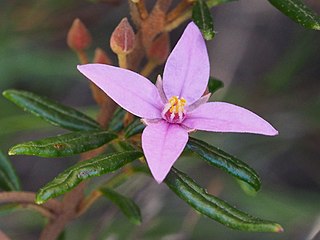
Boronia megastigma, commonly known as brown boronia, sweet-scented boronia or scented boronia, is a plant in the citrus family Rutaceae and is endemic in the south-west of Western Australia. It is a slender, erect shrub with aromatic leaves and flowers, the leaves with three or five leaflets and the flowers cup-shaped, dark brown to purplish black on the outside and yellow inside.

Boronia molloyae, commonly called the tall boronia, is a plant in the citrus family that is endemic to coastal regions in the south-west of Western Australia. It is a shrub with pinnate leaves that mostly have between three and seven leaflets, and deep rose pink, four-petalled flowers. It usually grows along streams in sandy soil.

Boronia muelleri, commonly known as the forest boronia or pink boroina, is a flowering plant that occurs in forest, woodland and heath in Victoria and New South Wales in Australia. It is an erect, woody shrub or small tree with pinnate leaves and up to fifteen pink to white four-petalled flowers arranged in leaf axils in spring and summer.

Boronia amabilis, commonly known as Wyberba boronia, is a plant in the citrus family, Rutaceae and is endemic to a small area in southern Queensland. It is an erect shrub with many branches, pinnate leaves with hairy lower surfaces and pink, four-petalled flowers.

Boronia duiganiae is a plant in the citrus family Rutaceae and is endemic to mountain ranges in south-east Queensland, Australia. It is an erect shrub with many branches, leaves with one, three or five leaflets, and pink to white, four-petalled flowers.

Boronia fastigiata, commonly known as bushy boronia, is a plant in the citrus family, Rutaceae and is endemic to the south-west of Western Australia. It is an erect shrub with small leaves and small groups of red, pink or purple, four-petalled flowers near the ends of the branches.

Boronia filifolia, commonly known as the slender boronia, is a plant in the citrus family Rutaceae and is endemic to south-eastern Australia. It is a slender shrub with simple or pinnate leaves and pale to deep pink four-petalled flowers.

Boronia juncea is a plant in the citrus family, Rutaceae and is endemic to the far south-west of Western Australia. It is an erect shrub with linear, short-lived leaves and groups of up to eight white to pink, four-petalled flowers.

Boronia pilosa, commonly known as the hairy boronia, is a plant in the citrus family Rutaceae and is endemic to south-eastern Australia. It is an erect, woody shrub with hairy branches, pinnate, sometimes hairy leaves and groups of up to ten white to pink, four petalled flowers.

Boronia warrumbunglensis is a plant in the citrus family Rutaceae and is endemic to a small area in the central west of New South Wales. It is a shrub with many branches, pinnate leaves and one or two pink, four-petalled flowers in the leaf axils. It is only known from the Warrumbungles and nearby districts.

Boronia angustisepala is a plant in the citrus family Rutaceae and is endemic to New South Wales, Australia. It is an erect shrub with many branches, pinnate leaves with up to eleven leaflets, and bright pink, four-petalled flowers.
Boronia citrata, commonly known as lemon boronia, is a plant in the citrus family, Rutaceae and is endemic to Victoria. It is an erect, woody shrub with pinnate, strongly lemon-scented leaves and pale pink to rosy pink, four-petalled flowers arranged in groups of up to five.

Boronia crassifolia is a plant in the citrus family, Rutaceae and is endemic to the south-west of Western Australia. It is a small, slender shrub with pinnate leaves, and yellowish green to brownish, four petalled flowers.

Boronia crassipes is a plant in the citrus family, Rutaceae and is endemic to the south-west of Western Australia. It is an erect, spindly, glabrous shrub with simple leaves, and pale red or pale mauve, four petalled flowers.

Boronia elisabethiae is a plant in the citrus family Rutaceae and is endemic to Tasmania. It is a semi-erect or weakly spreading, woody shrub with pinnate leaves and white to pink, four-petalled flowers.

Boronia filicifolia is a plant in the citrus family, Rutaceae and is endemic to the far north-west of Australia. It is an erect or sprawling shrub with many branches, pinnate leaves with up to 55 leaflets and white to pink flowers with the sepals a similar length to the petals.
Boronia interrex, commonly known as the Regent River boronia, is a plant in the citrus family, Rutaceae and is endemic to a small area in the Kimberley region of Western Australia. It is an erect, sometimes low-lying shrub with pinnate leaves, cream-coloured to pale pink sepals and pink petals, the sepals longer and wider than the petals.
Boronia montimulliganensis is a plant in the citrus family Rutaceae and is endemic to a single mountain in Queensland. It is an erect, woody shrub with pinnate or bipinnate leaves and white, four-petalled flowers usually arranged singly in leaf axils.

Boronia penicillata is a plant in the citrus family, Rutaceae and is endemic to the south-west of Western Australia. It is a low, spreading shrub with pinnate leaves and white flowers with four petals and eight stamens.

Boronia rubiginosa is a plant in the citrus family Rutaceae and is endemic to New South Wales in Australia. It is a shrub with pinnate leaves that are paler on the lower surface, and up to three pale to bright pink, four-petalled flowers in the leaf axils.


























